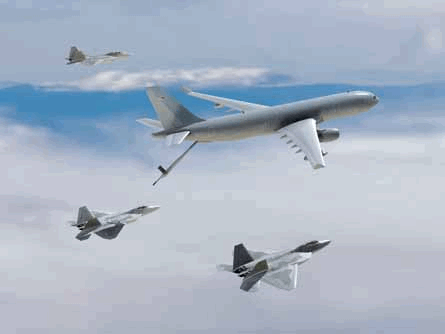Controversy is already brewing over proposed revisions made by the US Department of Defense as it reopens the terms of the KC-X tanker competition.
So far, the Northrop Grumman/EADS North America KC-30 team is not complaining about the amended request for proposals, but supporters of the Boeing KC-767 bid are dissatisfied about the schedule and revised terms.
After the DoD disclosed the one-week review period and 45-day turnaround for amended proposals, Boeing's public statement even contained a hint of frustration. "Given the very narrow window for commenting on this draft, our team is focused on identifying and understanding any changes," Boeing says.
 |
|---|
DoD plans to discuss any issues with the draft request for proposals with both bidders from 11 August, and to publish a final copy the following week. Initial responses are due by 1 October, with final revisions scheduled for November or December. Contract award is scheduled for around 24 December.
"We originally gave the offerers 60 days to submit proposals, so this is about the same amount of time," Shay Assad, director of defence procurement and acquisitions policy.
There are three major changes from the terms used by the US Air Force to select Northrop's Airbus A330-200F-based KC-30B in February. That decision was overturned on 19 June by the US Government Accountability Office, citing "significant" errors in the USAF evaluation.
The DoD has taken over management of the competition and appointed an entirely new source selection advisory committee as a result of the GAO's findings.
The key changes for the new evaluation include giving official credit for having the capacity to offload more fuel, the decoupling of maintenance and fuel cost estimates from acquisition costs and extending the life-cycle period from 25 years to 40 years.
As the larger aircraft in the competition, the KC-30B will gain an advantage in the evaluation by having more capacity to carry fuel than the KC-767, which is based on an all-new 767-200 variant.
One of Boeing's options to counter this advantage is to change its offer to the KC-777, although this could significantly drive up development and acquisition costs compared with its original bid. It could also offer a larger version of the 767, if engineers can overcome tail-strike limitations.
Extending the life-cycle period by 15 years, however, could pose a disadvantage for the larger KC-30B, which consumes more fuel than the KC-767.
But this issue could be mitigated by the decision to decouple acquisition and life-cycle cost estimates in the new evaluation, with estimates for near-term acquisition costs receiving more consideration.
"We've tried to be meticulous in ensuring that the offerers have a very clear and unambiguous understanding of the relative order of importance of our requirements," Assad says.
The revised proposals do not measure the impact of the award on the US industrial base, a requirement called for in a recent legislative proposal passed by the House of Representatives.
Assad, however, says that requirement was met before the original competitive phase began. "The purpose is to determine frankly before you start your competition whether you believe you have the industrial capability to supply these products. And I don't think there's any doubt about that," he says.
Source: Flight International



















